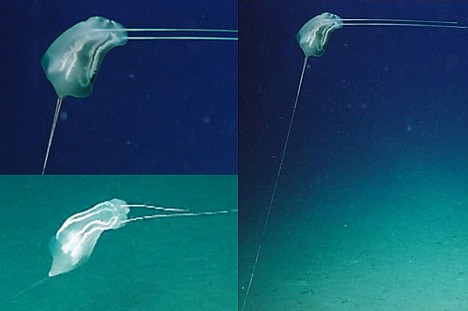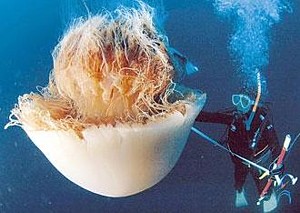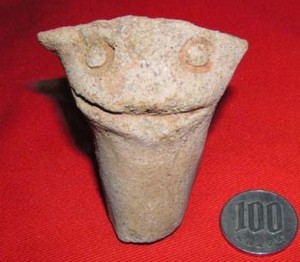
One of the world's rarest fungi, an exotic star-shaped mushroom known to exist at only three locations on Earth, has been discovered in the mountains of Nara prefecture.
The Devil's Cigar (a.k.a. "Texas Star") -- known to botanists as Chorioactis geaster -- had been observed only in central Texas and at two remote locations in Japan prior to the recent discovery in Nara. The peculiar fungus is described as a dark brown cigar-shaped capsule that transforms into a tan-colored star when it splits open to release its spores. It is also one of only a few known fungi that produce an audible hiss when releasing spores.
First reported in 1893 in Austin, Texas, the curious mushroom appears in a limited area of central Texas each year, and until now, the rare sightings in Japan have occurred in forests in Miyazaki and Kochi prefectures. The fungus is included on the red list of threatened species published by Japan's Environment Ministry.
The recent Nara discovery was made by Masakuni Kimura, curator of a natural history museum in the town of Kawakami (Nara prefecture). Kimura first encountered Devil's Cigars in October 2006 while surveying a forest near Kawakami, where he found 12 of them growing from a dead oak tree next to a mountain stream at an elevation of 470 meters (about 1,550 ft). Nearly a year later, in September 2007, he discovered four more of the mushrooms when he returned to the site with Shuichi Kurogi, curator of the Miyazaki Prefectural Museum of Nature and History. Their findings were presented at a recent meeting of the Mycological Society of Japan.
The site of the Nara discovery, like the previous Miyazaki and Kochi sites, is located in a humid forest. At all three sites, the Devil's Cigars were observed growing on dead oak trees near a stream.

Texas Star, the state fungus of Texas?!
In central Texas (which is located at approximately the same latitude as southern Japan), the rare fungus appears during fall and winter, growing from the stumps and dead roots of cedar elm trees.
Tsuyoshi Hosoya, head botanist at Japan's National Science Museum, says, "The DNA of the Devil's Cigar from Miyazaki is consistent with the one from Texas. They are regarded as the same species."
While it is unknown how this exceedingly rare mushroom came to appear only in Japan and central Texas, one intriguing theory suggests that spores from Japan were swept up in an Asian dust cloud and carried across the globe.
[Sources: Sankei, SAS via Watashi to Tokyo]

 Researchers at Japan's Jikei University will soon be checking the mailbox for a cool package from Siberia -- the recently discovered frozen body of an ancient baby mammoth. The nearly complete body of the female calf, said to be one of the best-preserved specimens of frozen mammoth ever discovered, is estimated to have been less than one year old before it was preserved in ice about 10,000 years ago.
Researchers at Japan's Jikei University will soon be checking the mailbox for a cool package from Siberia -- the recently discovered frozen body of an ancient baby mammoth. The nearly complete body of the female calf, said to be one of the best-preserved specimens of frozen mammoth ever discovered, is estimated to have been less than one year old before it was preserved in ice about 10,000 years ago. 
 In the latest development in Japan's war against giant
In the latest development in Japan's war against giant  Archaeologists in the town of Umi in Fukuoka prefecture have excavated a piece of earthenware shaped as the head of a creature with googly eyes and a big grin. Opinions are divided about whether this artifact, which was unearthed from a site dating back to the Muromachi period (1336 to 1573 AD), is supposed to represent the head of a demon, dragon, snake or kappa.
Archaeologists in the town of Umi in Fukuoka prefecture have excavated a piece of earthenware shaped as the head of a creature with googly eyes and a big grin. Opinions are divided about whether this artifact, which was unearthed from a site dating back to the Muromachi period (1336 to 1573 AD), is supposed to represent the head of a demon, dragon, snake or kappa.  On May 8, researchers from
On May 8, researchers from 
 Outcrops of combustible ice, or
Outcrops of combustible ice, or  A daikon radish with a distinctly human shape is the talk of the town in Sasamicho, Wakayama prefecture.
A daikon radish with a distinctly human shape is the talk of the town in Sasamicho, Wakayama prefecture.